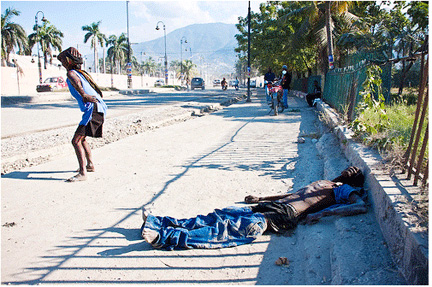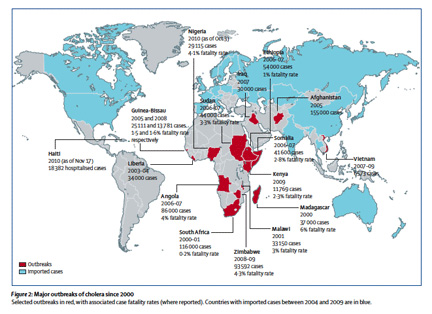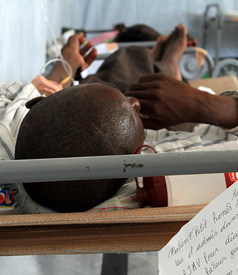This is an emergency.
Cholera is killing at least one person every 30 minutes in Haiti.
Over 2,000 people, and probably many more, succumbed to cholera during the first six weeks of the epidemic. Almost 100,000 people reached hospitals, but countless others never made it due to the country’s abysmal roads and lack of adequate health centers. On Dec. 17, the offical number of dead stood at 2,535, with a 2 percent fatality rate.

Killed by cholera? Or by the lack of clean water and sanitation? Photo taken from the “On The Goatpath” blog entry that documents how victims are buried in mass graves.
But in the Grande Anse, fatality is more like 12 percent. Sick people there are carried on a piece of plywood for up to four hours to the one clinic by groups of men, the victims’s diarreah and vomit running off the plank and onto the bearers and the paths, infecting new communities along the way.
Near the capital, a giant, unlined, uncovered “excreta pool” [front page of this dossier] contains thousands of gallons of feces, some of it likely infected with cholera. The pool a mile or so from the Bay of Port-au-Prince, and on top of the Plaine de Cul de Sac aquifer.
Anywhere from 200,000 to up to a million people will get the illness – and thousands will die – before cholera is eradicated, or rather, if it is eradicated.
Hasn’t this been covered already?
Many news reports have covered the outbreak already.
They’ve investigated who brought cholera to the Haiti. They’ve discussed how cholera is “ravaging” the country, written countless stories about elections, protests, and other events all “in the time of cholera,” in the “beleagured” and “stricken” Haiti. This piece on Palin jammed both adjectives into the title, saying she visited “earthquake-ravaged, cholera-striken Haiti.” The use of the passive voice makes it seem as though these ravages and strikes happen all on their own, like a lightening bolt.
But they don’t.
And not all Haitians face the same risks. Cholera is a disease of the poor, of the disenfranchised. Poor people in poor countries. Cholera thrives where there is no clean water, where there is inadequate sanitation, where there are poor health systems.

Cholera epidemics since 2000. The Lancet, vol. 376, 11-12-2010.
While it’s now clear that UN soldiers likely brought Vibrio cholera to Haiti, and while it is also clear that good health care, access to a clean water and sanitation, good hygiene practices and a vaccine can keep it at bay, it’s not clear how to achieve all of that before many thousands more die.
And even if cholera is beaten, dozens of other waterborne diseases threaten Haiti. According to the World Health organization, every year 1.4 million people die from waterborne diseases – about four per minute – most as a result of unsafe and inadequate water and sanitation.
Haiti Grassroots Watch decided to dig into the why and the how of Haiti’s “ravaged” and “striken” situation and asked
- Why has cholera taken hold so easily?
- Why don’t Haitians have access to clean water and adequate sanitation?
- And if all $164 million the UN is seeking is rounded up and cholera eradicated, what will keep another water-borne disease from sweeping ghrough the country?
Watch:
Also Read:
Behind the Cholera Epidemic: Excreta
We’re not backing down in the face of Trump’s threats.
As Donald Trump is inaugurated a second time, independent media organizations are faced with urgent mandates: Tell the truth more loudly than ever before. Do that work even as our standard modes of distribution (such as social media platforms) are being manipulated and curtailed by forces of fascist repression and ruthless capitalism. Do that work even as journalism and journalists face targeted attacks, including from the government itself. And do that work in community, never forgetting that we’re not shouting into a faceless void – we’re reaching out to real people amid a life-threatening political climate.
Our task is formidable, and it requires us to ground ourselves in our principles, remind ourselves of our utility, dig in and commit.
As a dizzying number of corporate news organizations – either through need or greed – rush to implement new ways to further monetize their content, and others acquiesce to Trump’s wishes, now is a time for movement media-makers to double down on community-first models.
At Truthout, we are reaffirming our commitments on this front: We won’t run ads or have a paywall because we believe that everyone should have access to information, and that access should exist without barriers and free of distractions from craven corporate interests. We recognize the implications for democracy when information-seekers click a link only to find the article trapped behind a paywall or buried on a page with dozens of invasive ads. The laws of capitalism dictate an unending increase in monetization, and much of the media simply follows those laws. Truthout and many of our peers are dedicating ourselves to following other paths – a commitment which feels vital in a moment when corporations are evermore overtly embedded in government.
Over 80 percent of Truthout‘s funding comes from small individual donations from our community of readers, and the remaining 20 percent comes from a handful of social justice-oriented foundations. Over a third of our total budget is supported by recurring monthly donors, many of whom give because they want to help us keep Truthout barrier-free for everyone.
You can help by giving today. Whether you can make a small monthly donation or a larger gift, Truthout only works with your support.
